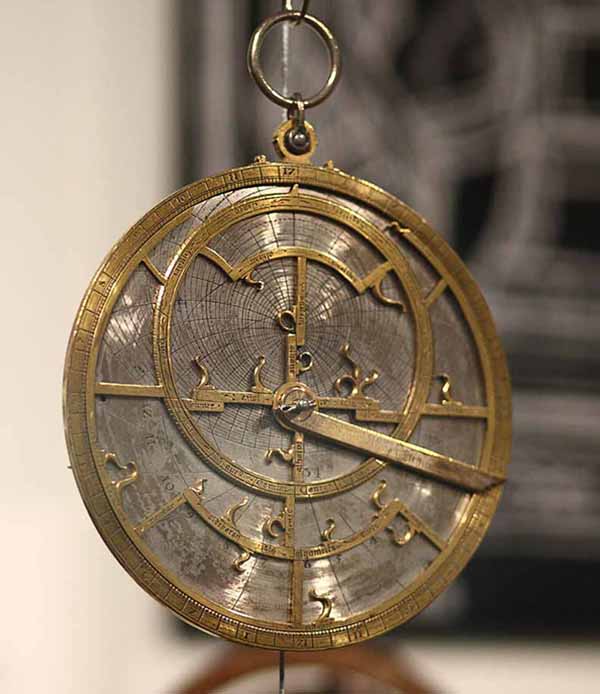

An astrolabe is an elaborate inclinometer, historically used by astronomers and navigators to measure the inclined position in the sky of a celestial body, day or night. It can thus be used to identify stars or planets, to determine local latitude given local time (and vice versa), to survey, or to triangulate. It was used in classical antiquity, the Islamic Golden Age, the European Middle Ages, and the Renaissance for all these purposes. The astrolabe is effective for determining latitude on land or calm seas, although it is less reliable on the heaving deck of a ship in rough seas. The mariner's astrolabe was developed to solve that problem.
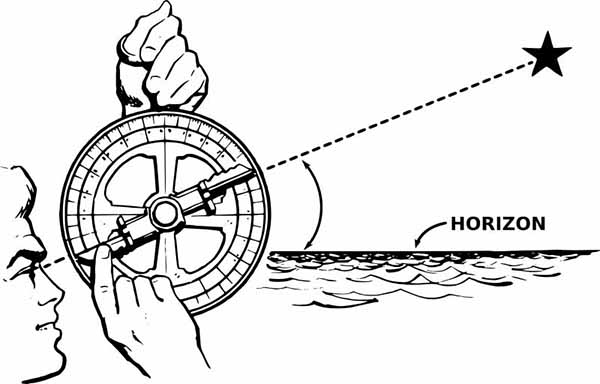
An early astrolabe was invented in the Hellenistic civilization by Apollonius of Perga between 220 and 150 BC, often attributed to Hipparchus. The astrolabe was a marriage of the planisphere and dioptra, effectively an analog calculator capable of working out several different kinds of problems in spherical astronomy. Theon of Alexandria (c. 335 - c. 405) wrote a detailed treatise on the astrolabe, and Lewis argues that Ptolemy used an astrolabe to make the astronomical observations recorded in the Tetrabiblos. Some historians attribute the astrolabe's invention to Hypatia, the daughter of Theon of Alexandria, noting that her student Synesius credits her for the invention in his letters.
Astrolabes continued in use in the Greek-speaking world throughout the Byzantine period. About 550 AD, Christian philosopher John Philoponus wrote a treatise on the astrolabe in Greek, which is the earliest extant treatise on the instrument. Mesopotamian bishop Severus Sebokht also wrote a treatise on the astrolabe in the Syriac language in the mid-7th century. Sebokht refers to the astrolabe as being made of brass in the introduction of his treatise, indicating that metal astrolabes were known in the Christian East well before they were developed in the Islamic world or in the Latin West.
Astrolabes were further developed in the medieval Islamic world, where Muslim astronomers introduced angular scales to the design adding circles indicating azimuths on the horizon. It was widely used throughout the Muslim world, chiefly as an aid to navigation and as a way of finding the Qibla, the direction of Mecca. Eighth-century mathematician Muhammad al-Fazari is the first person credited with building the astrolabe in the Islamic world.
The mathematical background was established by Muslim astronomer Albatenius in his treatise Kitab az-Zij (c. 920 AD), which was translated into Latin by Plato Tiburtinus (De Motu Stellarum). The earliest surviving astrolabe is dated AH 315 (927-28 AD).
In the Islamic world, astrolabes were used to find the times of sunrise and the rising of fixed stars, to help schedule morning prayers (salat).
In the 10th century, al-Sufi first described over 1,000 different uses of an astrolabe, in areas as diverse as astronomy, astrology, navigation, surveying, timekeeping, prayer, Salat, Qibla, etc.
The spherical astrolabe was a variation of both the astrolabe and the armillary sphere, invented during the Middle Ages by astronomers and inventors in the Islamic world. The earliest description of the spherical astrolabe dates back to Al-Nayrizi (fl. 892-902). In the 12th century, Sharaf al-Din al Tusi invented the linear astrolabe, sometimes called the "staff of al-Tusi", which was "a simple wooden rod with graduated markings but without sights. It was furnished with a plumb line and a double chord for making angular measurements and bore a perforated pointer". The geared mechanical astrolabe was invented by Abi Bakr of Isfahan in 1235.
Peter of Maricourt wrote a treatise on the construction and use of a universal astrolabe in the last half of the 13th century entitled Nova compositio astrolabii particularis. Universal astrolabes can be found at the History of Science Museum in Oxford.
English author Geoffrey Chaucer (c. 1343-1400) compiled A Treatise on the Astrolabe for his son, mainly based on Messahalla. The same source was translated by French astronomer and astrologer Pelerin de Prusse and others. The first printed book on the astrolabe was Composition and Use of Astrolabe by Christian of Prachatice, also using Messahalla, but relatively original.
In 1370, the first Indian treatise on the astrolabe was written by the Jain astronomer Mahendra Suri.
The first known metal astrolabe in Western Europe is the Destombes astrolabe made from brass in tenth-century Spain. Metal astrolabes avoided the warping that large wooden ones were prone to, allowing the construction of larger and therefore more accurate instruments. Metal astrolabes were heavier than wooden instruments of the same size, making it difficult to use them in navigation.
The astrolabe was almost certainly first brought north of the Pyrenees by Gerbert of Aurillac (future Pope Sylvester II), where it was integrated into the quadrivium at the school in Reims, France sometime before the turn of the 11th century. In the 15th century, French instrument maker Jean Fusoris (c. 1365-1436) also started remaking and selling astrolabes in his shop in Paris, along with portable sundials and other popular scientific devices of the day. Thirteen of his astrolabes survive to this day. One more special example of craftsmanship in early 15th-century Europe is the astrolabe designed by Antonius de Pacento and made by Dominicus de Lanzano, dated 1420.
In the 16th century, Johannes Stöffler published Elucidatio fabricae ususque astrolabii, a manual of the construction and use of the astrolabe. Four identical 16th-century astrolabes made by Georg Hartmann provide some of the earliest evidence for batch production by division of labor.
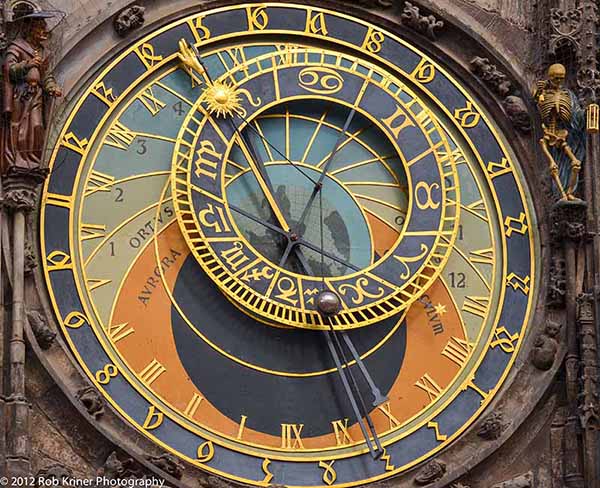
Mechanical astronomical clocks were initially influenced by the astrolabe; they could be seen in many ways as clockwork astrolabes designed to produce a continual display of the current position of the sun, stars, and planets. For example, Richard of Wallingford's clock (c. 1330) consisted essentially of a star map rotating behind a fixed rete, similar to that of an astrolabe.
Many astronomical clocks use an astrolabe-style display, such as the famous clock at Prague, adopting a stereographic projection of the ecliptic plane. In recent times, astrolabe watches have become popular. For example, Swiss watchmaker Dr. Ludwig Oechslin designed and built an astrolabe wristwatch in conjunction with Ulysse Nardin in 1985. Dutch watchmaker Christaan van der Klauuw also manufactures astrolabe watches today.
An astrolabe consists of a disk, called the mater (mother), which is deep enough to hold one or more flat plates called tympans, or climates. A tympan is made for a specific latitude and is engraved with a stereographic projection of circles denoting azimuth and altitude and representing the portion of the celestial sphere above the local horizon. The rim of the mater is typically graduated into hours of time, degrees of arc, or both.
Above the mater and tympan, the rete, a framework bearing a projection of the ecliptic plane and several pointers indicating the positions of the brightest stars, is free to rotate. These pointers are often just simple points, but depending on the skill of the craftsman can be very elaborate and artistic. There are examples of astrolabes with artistic pointers in the shape of balls, stars, snakes, hands, dogs' heads, and leaves, among others. The names of the indicated stars were often engraved on the pointers in Arabic or Latin. Some astrolabes have a narrow rule or label which rotates over the rete, and may be marked with a scale of declinations.
The rete, representing the sky, functions as a star chart. When it is rotated, the stars and the ecliptic move over the projection of the coordinates on the tympan. One complete rotation corresponds to the passage of a day. The astrolabe is therefore a predecessor of the modern planisphere.
On the back of the mater there is often engraved a number of scales that are useful in the astrolabe's various applications. These vary from designer to designer, but might include curves for time conversions, a calendar for converting the day of the month to the sun's position on the ecliptic, trigonometric scales, and a graduation of 360 degrees around the back edge. The alidade is attached to the back face. An alidade can be seen in the lower right illustration of the Persian astrolabe above. When the astrolabe is held vertically, the alidade can be rotated and the sun or a star sighted along its length, so that its altitude in degrees can be read ("taken") from the graduated edge of the astrolabe hence the word's Greek roots: "astron" = star + "lab" = to take. Read more ...
Rare eleventh-century astrolabe discovery reveals Islamic-Jewish scientific exchange PhysOrg - March 4, 2024
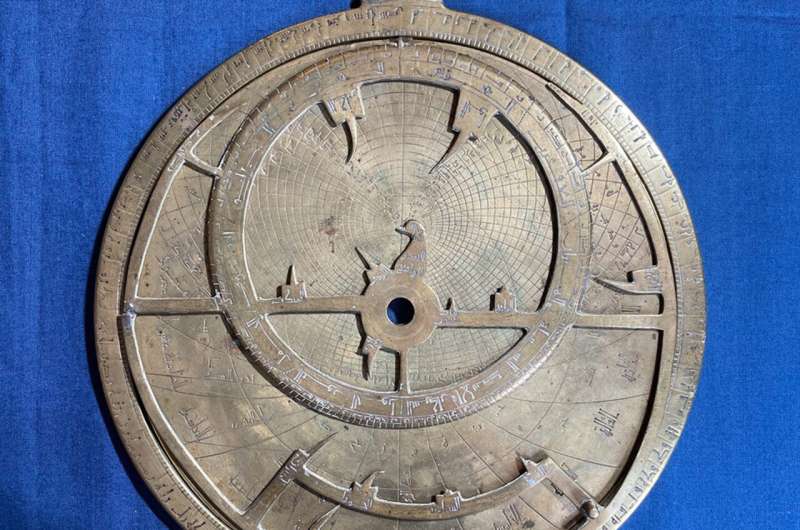
The identification of an eleventh-century Islamic astrolabe bearing both Arabic and Hebrew inscriptions makes it one of the oldest examples ever discovered and one of only a handful known in the world. The astronomical instrument was adapted, translated, and corrected for centuries by Muslim, Jewish, and Christian users in Spain, North Africa, and Italy.
The Astrolabe Arcane Navigation Device Holds a Hidden Clue That Reveals Its Origins Science Alert - December 16, 2023

Astrolabes serve two purposes. First, they are useful as an astronomical tool, especially for finding a ship's latitude. But second, they are works of art in themselves. Besides having to be precise, many are beautiful. They are even seeing a resurgence in popularity as collectors lap up even those made by modern manufacturing processes because of their aesthetic appeal. Now, a new paper adds to their uses – a self-referential ability to mark what year they were made by the patterns of the stars they reference.
Earliest known Mariner's Astrolabe research Science Daily - March 18, 2019

Guinness World Records have independently certified an astrolabe excavated from the wreck site of a Portuguese Armada Ship that was part of Vasco da Gama's second voyage to India in 1502-1503 as the oldest in the world, and have separately certified a ship's bell (dated 1498) recovered from the same wreck site also as the oldest in the world
'Earliest known marine navigation tool' is uncovered on the shipwrecked Esmeralda that sank off the Oman coast during a violent storm 500 years ago Daily Mail - October 24, 2017

The oldest known marine navigation tool has been excavated from a shipwreck that sank in a violent storm off the coast of Oman in 1503. Archaeologists say the navigation tool, known as an astrolabe, would have been used by mariners in the Age of Discovery to measure the position of the sun on trans-oceanic voyages. The item was recovered from a ship called 'Esmeralda', which sank in the Indian Ocean, killing all on board, including its captain who was the uncle of famous Portuguese explorer Vasco da Gama.
The astrolabe, which is 17.5cm in diameter and less than 2mm thick, was used by mariners to measure the altitude of the sun during voyages. When the researchers found the object, no markings were visible. But scans by Warwick University showed etches around the edge of the object, each separated by five degrees – proving that it is an astrolabe. These markings would have allowed mariners to measure the height of the sun above the horizon at noon to determine their location so they could find their way on the high seas. The artifact is also engraved with the Portuguese coat of arms and the personal emblem of Don Manuel I, the King of Portugal from 1495-1521. Scientists say it is the earliest known example of an astrolabe by several decades.
It's Official: Earliest Known Marine Astrolabe Found in Shipwreck Live Science - October 25, 2017
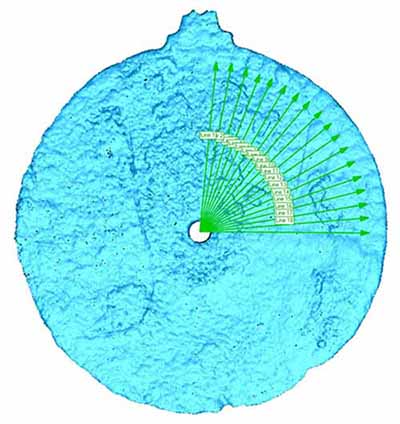
More than 500 years ago, a fierce storm sank a ship carrying the earliest known marine astrolabe - a device that helped sailors navigate at sea, new research finds. Divers found the artifact in 2014, but were unsure exactly what it was at the time. Now, thanks to a 3D-imaging scanner, scientists were able to find etchings on the bronze disc that confirmed it was an astrolabe.